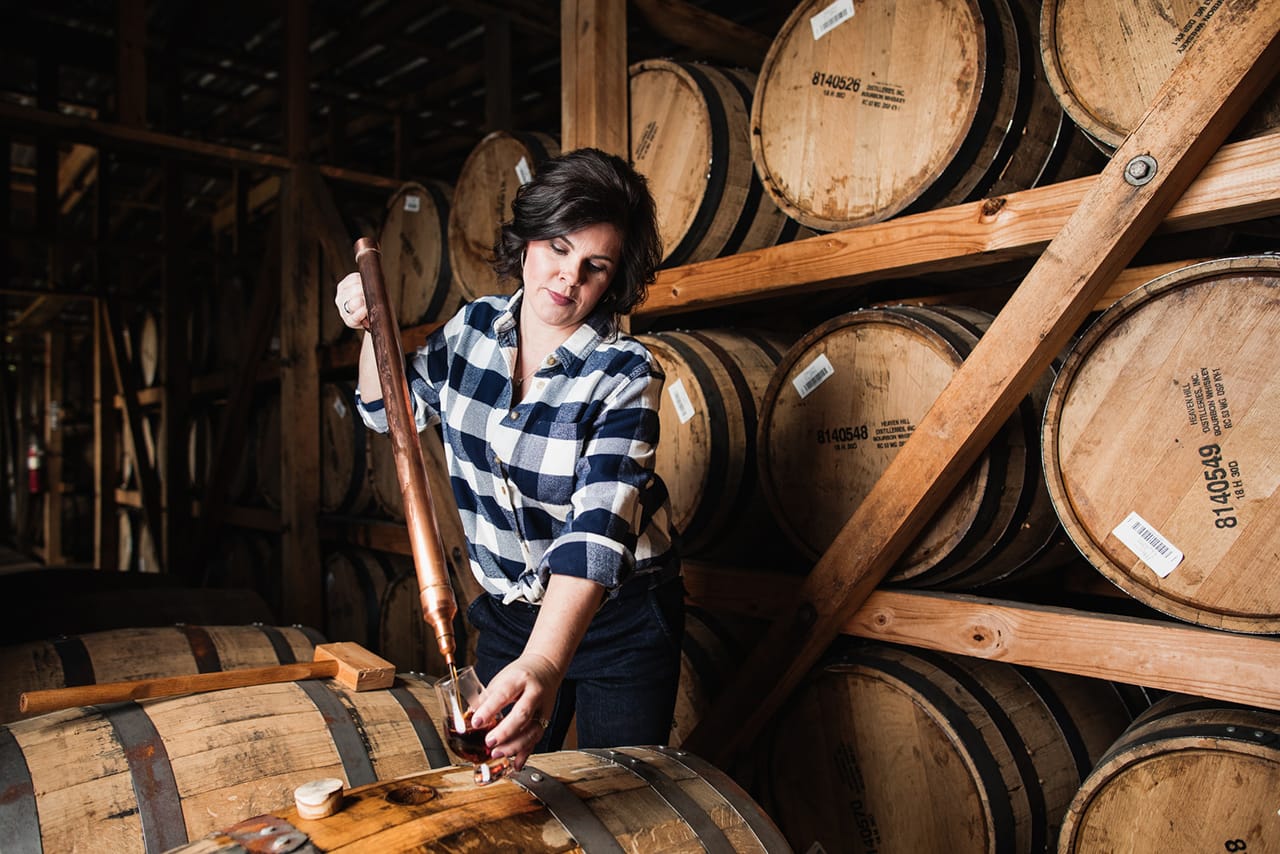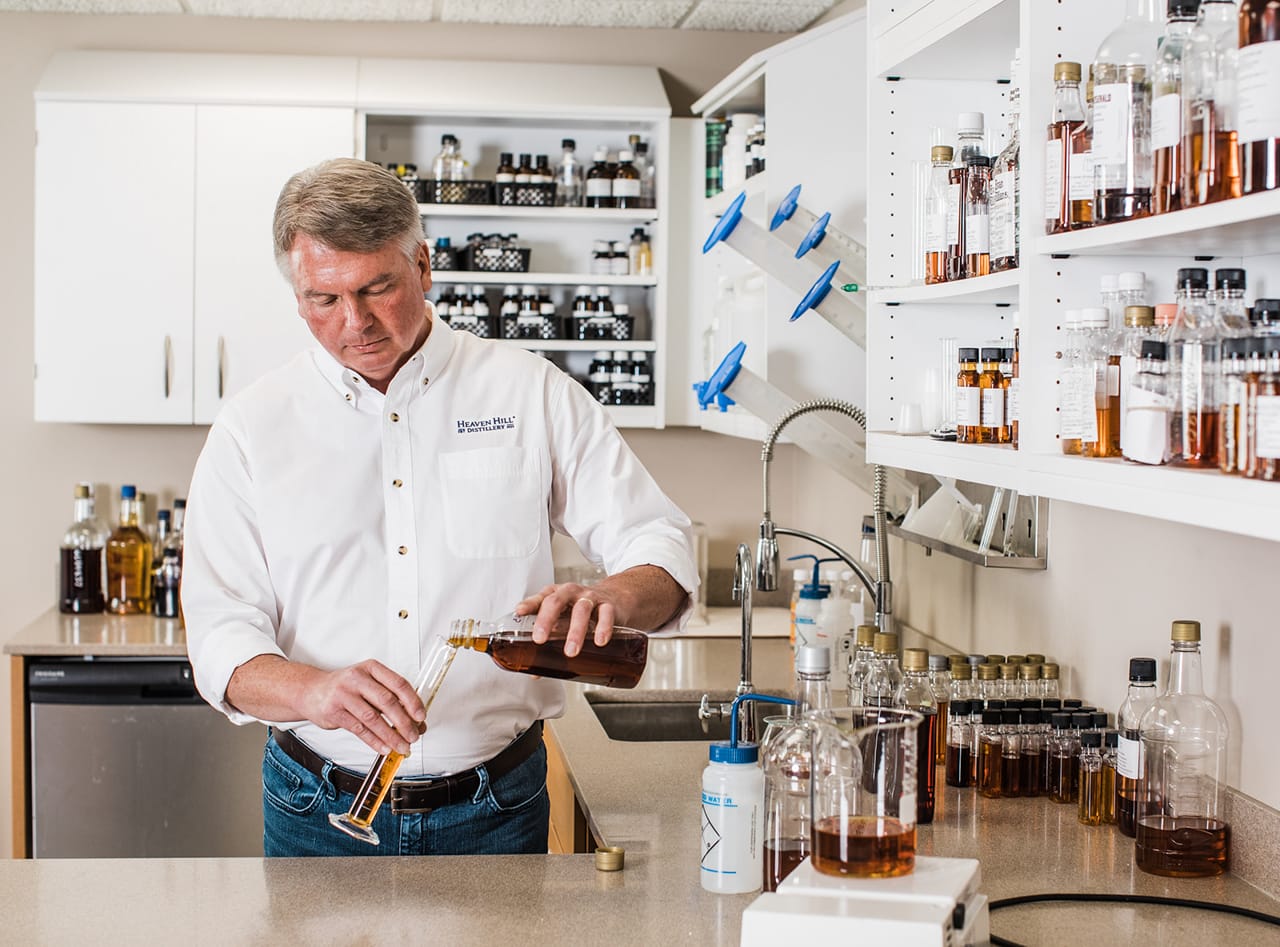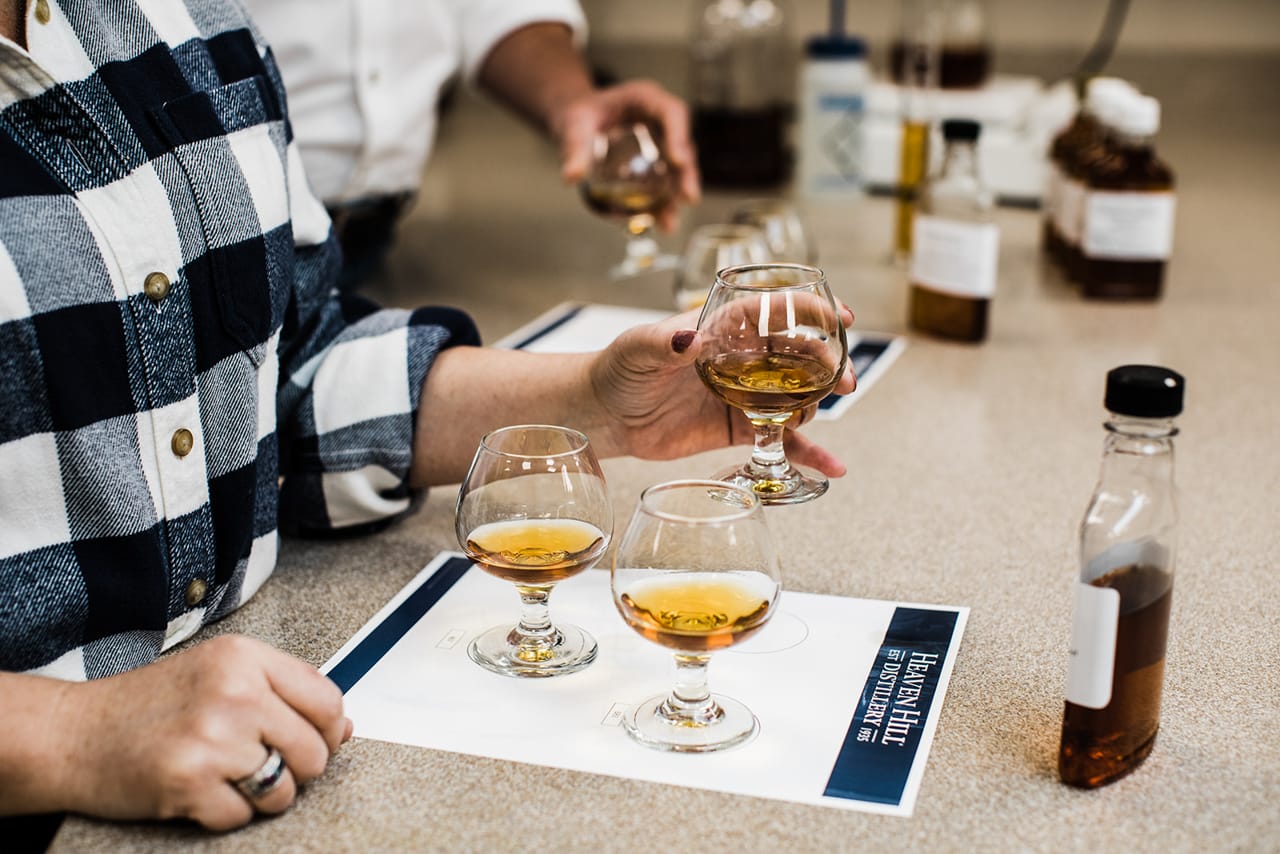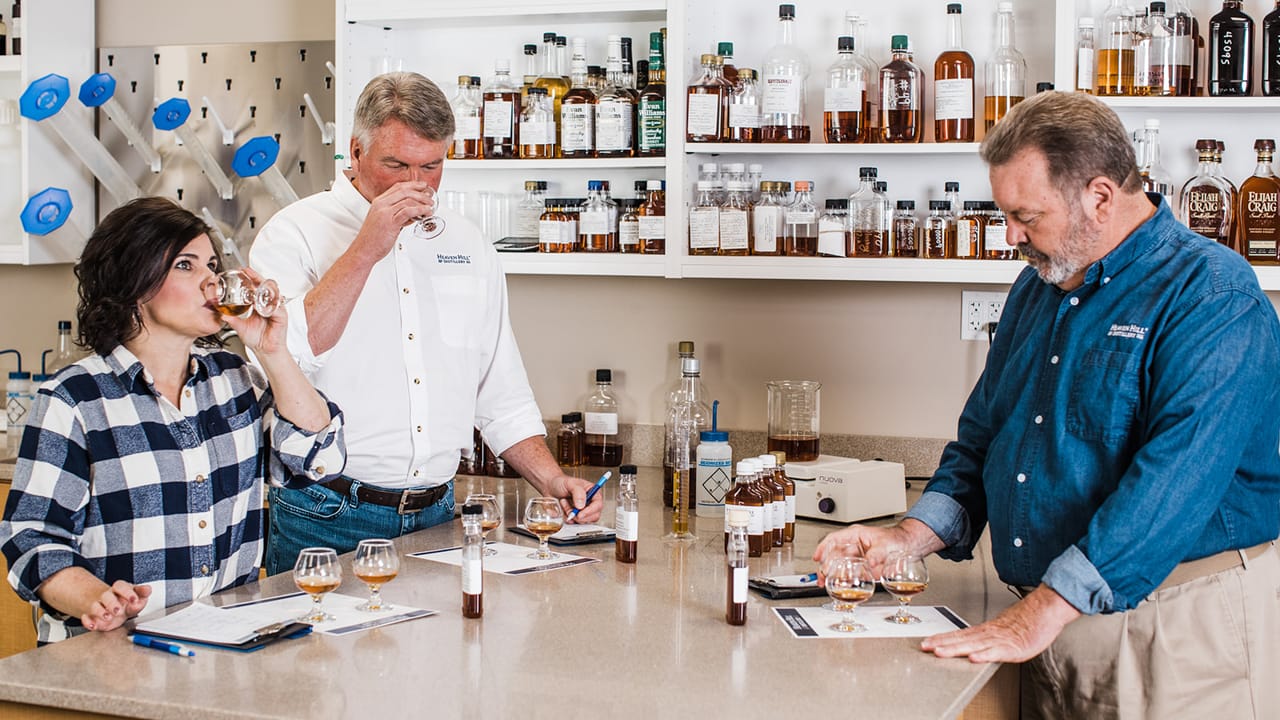Every whiskey barrel and batch sample delivered to Heaven Hill Distillery’s quality control lab undergoes rigorous chemical analysis. But until our human tasting team approves them, none gets bottled.
The toughest test is the three-person gauntlet of scrutiny known as Chris Briney, Tawnie Gootee and Mike Sonne. With nearly 100 years of collective experience at the distillery, they know better than anyone how our whiskeys must look, smell and taste. And believe it or not, approval for bottling can get even tougher when these veterans don’t always agree.
“That’s why there’s three of us–because we don’t always agree,” said Mike Sonne, who heads up the tasting team and has logged four decades of experience at Heaven Hill. He’s been our Process Engineer and Master Taster since 2012. “But 90 percent of the time we agree on what we’re tasting.”
Human analysis of whiskey is a group effort requiring flexibility and listening to one’s peers, said Chris Briney, Director of New Product Development and Quality Assurance.
“All three of us know we have to bend a little now and then, especially if two gang up on one,” Briney said. “Sometimes that means yielding slightly to the others, but not without a discussion. If they say I’m wrong on something, I want to know what that is.”

Tawnie Gootee, a Bottling Specialist in Quality Assurance, puts it this way: “Sometimes it’s hard because you get stuck into a corner where you have to let it go. But we’re all close and we respect each others’ abilities. It’s our job to think about what customers expect, so we’re really serious about that.”
Which sometimes means Sonne and Briney let Gootee make the call.
“Tawnie has said many times, ‘I’m not going to approve that,’” Sonne said, “and we’ll bend some there.”
Best job in the world?
When people learn that Gootee, Briney and Sonne taste whiskey for a living, they assume it’s the world’s best job. While all agree that it’s fun work, they say their jobs are exacting and demanding.
“It’s not about sitting around and drinking whiskey all day,” Sonne said. Tasting is essential, but all have myriad other responsibilities outside that desired duty.
“Glamorous as it is, it’s still a job,” Briney joked.
“He’s right,” Gootee said, “I look at it as my job. But there are those days when you get to taste something truly great. That’s fun.”
To Gootee, whiskey tasting is mostly about sleuthing out shortcomings in whiskey batches. If a sample “tastes off,” she consults her peers. If all agree it needs help, then the batch is adjusted by blending in more whiskey to achieve the correct flavor.
To help her detect anomalies such as off aromas, Gootee adds lots of distilled water to her samples.
“I can catch a batch being off the mark with only about 30 percent of Bourbon in my sample,” she said. But even as confident as she is in her assessments, Gootee occasionally checks reference bottles. “I have a cabinet in the lab with retained samples that I’ll go to if I’m questioning myself.”

Briney works similarly, adding water before nosing a spirit. Sonne whiffs the straight spirit sample first, and then adds water.
Essential to the job is staying sober, of course, which is a challenge given the sheer amount of sampling required. Spitting is a must.
Sonne said he’ll sample as many as 18 whiskeys per day, while Gootee tests double that amount.
“But even that doesn’t count all the line samples,” she said. “This morning, I had 30 single barrels to taste and 14 tank samples. You drink lots of water if you do this.”
Is there ever a time when swallowing is necessary? All said yes.
“On our premium offerings, I don’t spit,” Sonne said. “I’ll smell and taste, but only swallow a small amount.”
“To gauge finish, you only need to swallow a small amount anyway,” Briney added.
Asked how they combat palate fatigue when tasting whiskey, Gootee said she does “nothing special,” while Briney “rinses a lot.” Sonne said he tries to sample no more than six whiskeys at once before “I have to walk away for a while.”
Tracking the flow of whiskey
Assessing the influences of time, climate, and the barrel aging process is highly nuanced. To have a tasting team able to blend as many as 1,500 unique barrels for a single batch of whiskey requires deep experience, says Conor O’Driscoll, Master Distiller at Heaven Hill.

“Mike, Tawnie and Chris were tasting and selecting Heaven Hill’s whiskeys when Parker Beam was master distiller—and long before the 1996 fire,” O’Driscoll said. “It’s people like them who set Heaven Hill apart by delivering consistency and high-quality whiskeys year-over-year .”
O’Driscoll said that Sonne’s role in selecting each batch’s barrels is especially crucial, and his mastery of the task is exceptional.
“In Mike’s head is the matrix, if you will, of where a given style of whiskey should be aged depending on which brand it might become,” O’Driscoll said. “He knows, for example, whether a batch of wheated Bourbon should be put on the middle to upper floors of a warehouse at Cox’s Creek to become Larceny, or whether it should be placed at one of our bigger brick warehouses at the Bernheim distillery. There, it can mature more slowly and become an Old Fitzgerald release 12, 13, even 15 years from now. His deep, granular knowledge is especially important when selecting our single barrel products like Henry McKenna.”
Briney said Sonne’s kind of mental mastery—assisted by Heaven Hill’s proprietary barrel inventory control software—becomes more impressive by the day as the distillery experiences unprecedented growth.
“The daily logistics of adding 1,300 new barrels, and pulling out 1,000 for bottling, sampling them, and keeping up with quality control can be overwhelming,” Briney said. “We’re working strategically to be more data driven in our decision making.”
Sonne also chooses barrels based on knowing the unique aging performance of Heaven Hill’s 60 rickhouses. All six Heaven Hill campuses feature buildings of different ages, construction methods, heights, and barrel capacities. Just as importantly, all are uniquely affected by how the wind and sun hit and heat them, as well as their geographic elevation.
“Warehouses by our Bardstown headquarters age differently from those at Cox’s Creek, which age differently than the brick buildings at Bernheim, which age differently than the tiered warehouses at Deatsville,” Sonne said.
[Discover more about how the variation in weather and climate
can affect how a barrel will age]
What he also knows from experience is that the age painted onto each barrel head is a less important determiner of the whiskey’s character than where the actual barrel was stored.
“A 7-year-old whiskey stored on the 7th floor of a warehouse tastes more like an eight-and-a-half-year-old, and a 7-year-old on the first floor tastes more like a five-and-a-half-year-old,” he said. “So, if I pull barrels from the upper floors of the warehouse, I also add some first-floor barrels to balance the batch.”
Tasting is a mental game
Briney said tasting is very much a mental activity requiring “you to get your head in the right place, to focus on what that particular spirit should taste like, and not let your palate be confused.”
Gootee agreed. “I go into it thinking, ‘Everyone’s done their job, and this is going to taste like it’s supposed to,” she said. She tastes quickly, not lingering over each sample, and “then, if something just jumps out at me, that’s when I go back to it.”
Gootee added that the room also has to be right, as in no unwanted aromas. Once, a staffer was “checking flavor samples in an office a hallway away from mine, and I could still smell those flavors. That means it’s influencing me.”

Interestingly, none of the tasting trio ever received professional sensory training. All learned the task on the job. Briney said both of his colleagues “have a gifted palate,” and that it’s “a rare event when someone combines olfactory and taste gifts with years of experience. They can put their finger exactly on what’s not quite right about a product and then describe that to others—it’s amazing. I listen closely to what they say about things we taste and then try to catalogue in my brain the nuances they pick up.”
Gootee laughed a little when asked about her training until adding that she received the best education possible.
“I started out not knowing anything about other distillery’s whiskeys, so I got to know only Heaven Hill’s first,” she said. “So I learned everything about our Bourbons without even knowing what others tasted like. That turned out to be great for me!”
Learn more about
Mike Sonne, Master Taster




























